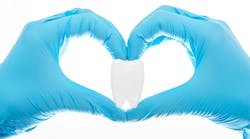World Food Day: Healthy food for oral health
World Food Day is celebrated annually on October 16, the anniversary of the founding of the Food and Agriculture Organization (FAO).
The foods we eat significantly impact the condition of our teeth and gums, affecting everything from tooth decay to gum disease. Certain foods support strong teeth and healthy gums, while others can accelerate tooth decay and erosion. Including nutrient-rich foods in your diet helps maintain healthy teeth and gums and improves overall oral health.
Foods that are good for oral health
Dairy products (milk, cheese, yogurt): Dairy products are rich in calcium and phosphates, essential minerals for strengthening and building tooth enamel. “Calcium is one of the most important minerals for dental health,” says Hanna Lähteenmäki, oral hygienist (YAMK), PhD. “Yogurt and cheese are excellent choices as they help strengthen enamel and protect teeth from acid attacks.”
Green leafy vegetables (such as spinach, kale): Green leafy vegetables are packed with vitamins and minerals that support oral health. They are rich in calcium, which strengthens tooth enamel, and folic acid, which promotes gum health. “Many patients don’t know that dark green vegetables can improve gum health,” adds Lähteenmäki, head of the Finnish Association of Dental Hygienists (FADH). “There should be more of these on everyone’s plate,” she continues.
Crunchy vegetables: Crunchy vegetables, such as carrots and celery, act as natural toothbrushes. Chewing them increases the secretion of saliva, which flushes away food debris and bacteria. “Saliva is nature’s cleaning mechanism,” explains Lähteenmäki. “The more you chew healthy, crunchy vegetables, the more saliva is produced, which protects your teeth from decay.”
Vitamin C-rich fruits and berries: Vitamin C is essential for gum health and strengthening blood vessels and connective tissues. “Vitamin C helps prevent gum recession and gum disease,” says Lähteenmäki. “Although citrus fruits can be acidic when consumed in moderation, they are an excellent choice for oral health.”
Lähteenmäki points out that lingonberries, like many other berries, have also been found to have anti-inflammatory or anti-inflammatory effects on the oral mucosa. For example, lingonberries are used in traditional medicine in Finland to treat yeast infections in the mouth, among other things. Lingonberries contain cranberrylike compounds that can prevent bacteria from adhering to teeth, thus reducing the risk of tooth decay. Lingonberries are a promising natural approach to improving oral health through their antioxidant, anti-inflammatory, antiproteolytic, anticancer, and antimicrobial effects.1
Nuts (almonds, walnuts, cashews): Nuts provide essential nutrients such as calcium, magnesium and phosphorus that strengthen teeth and keep jaws healthy. “Nuts are a great healthy snack that nourishes the body and helps protect teeth from decay,” says Lähteenmäki.
Green tea: Green tea is rich in antioxidants, especially catechins, which fight bacteria and reduce inflammation.2 It can also help reduce plaque buildup and the risk of tooth decay and gum disease. “I recommend green tea to patients as it is a natural way to reduce plaque buildup and promote oral health,” says Lähteenmäki.
Water/hydration: Water is essential for oral health. It helps flush away food debris, bacteria, and acids that can damage teeth. Good fluid balance is critical for saliva production. Saliva is an essential oral defense mechanism as it helps flush oral bacteria from the mouth. Adults should aim to drink at least 1–1.5 liters of water daily, which is roughly equivalent to 8–10 glasses of water a day, to maintain good oral health.3
Foods to limit consumption of
While some foods are good for your teeth and gums, others can increase the risk of tooth decay and gum disease.
Sugary foods and drinks: Sugar is one of the biggest causes of tooth decay. Bacteria in the mouth use sugar as food and produce acids that erode tooth enamel and lead to tooth decay. “Reducing sugar is one of the most effective ways to protect your teeth,” says Lähteenmäki.
Starchy foods (white bread, pasta): Starches, especially processed carbohydrates, can get stuck in the teeth and break down in the mouth into sugar, which feeds bacteria. These can easily leave sticky residues on the teeth, which act as a good substrate for biofilm and bacterial food if they are not regularly removed by careful oral hygiene. Biofilm is a complex community of microorganisms that can form on the teeth and gums, leading to various oral health issues if not managed effectively.
Take oral hygiene to the next level
Maintaining a balanced diet and making informed food choices are crucial to promoting oral health. Understanding that what you eat has a significant impact on the health of the mouth and the whole body can be a powerful motivator to make healthier food choices. “Oral health starts at the plate,” says Lähteenmäki. “What you eat matters.”
While drinking water and consuming many foods can benefit oral health, careful daily oral hygiene routines are equally important for maintaining a healthy mouth. These include daily brushing and flossing, and regular dental checkups. These checkups are a proactive step in maintaining oral health and can help catch any issues early on. However, studies have shown that even a high-quality electric toothbrush only removes about 65% of harmful bacteria in the mouth.4
Antibacterial Lumoral treatment (available in many European and Asian countries) enhances the effects of toothbrushing. It is a noninvasive, light-based treatment that significantly improves the results of professional oral care in a preventive way. Lumoral helps to slow down plaque formation, considerably reducing the burden of harmful bacteria in the mouth. It can be used as a part of the daily oral care routine, following the advice of dental professionals.5
References
- Pärnänen P, Lähteenmäki H, Tervahartiala T, Räisänen IT, Sorsa T. Lingonberries–general and oral effects on the microbiome and inflammation. Nutrients. 2021;13(11):3738. doi:10.3390/nu13113738
- Musial C, Kuban-Jankowska A, Gorska-Ponikowska M. Beneficial properties of green tea catechins. Int J Mol Sci. 2020;21(5):1744. doi:10.3390/ijms21051744
- Fedorciw R. The oral health benefits of drinking water. Smile Drs. July 23, 2021. https://smiledrs.com/the-oral-health-benefits-of-drinking-water/
- Aggarwal N, Gupta S, Grover R, Sadana G, Bansal K. Plaque removal efficacy of different toothbrushes: a comparative study. Int J Clin Pediatr Dent. 2019;12(5):385-390. doi:10.5005/jp-journals-10005-1669
- Pakarinen S, Saarela RKT, Välimaa H, et al. Home-applied dual-light photodynamic therapy in the treatment of stable chronic periodontitis (HOPE-CP)—three-month interim results. Dent J (Basel). 2022;10(11):206. doi:3390/dj10110206
About the Author

Nina Garlo-Melkas, MSc
Nina Garlo-Melkas, MSc, is a health and science journalist.



